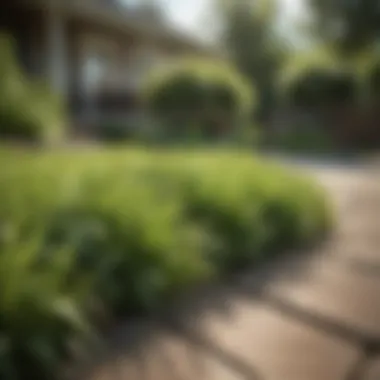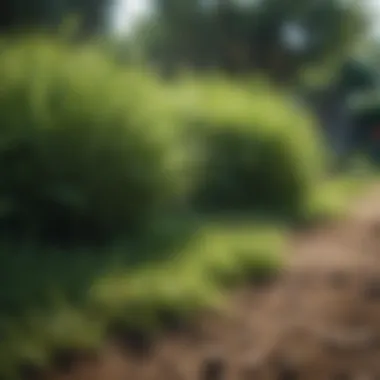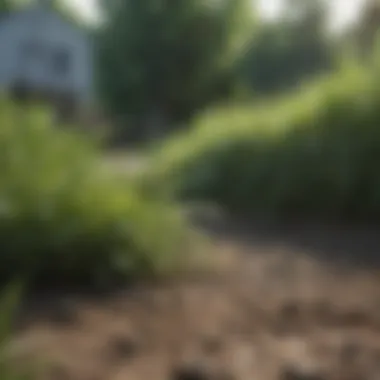Effective Strategies to Prevent Crabgrass Growth


Intro
Maintaining a beautiful garden or lawn is a labor of love, yet many homeowners often find themselves in an uphill battle against pervasive weeds like crabgrass. Its ability to thrive in diverse environments makes it a formidable opponent, especially for those seeking pristine landscapes. This article aims to shed light on effective strategies to prevent crabgrass from infiltrating your green spaces. We will focus on various aspects from understanding its biology to practical weed management techniques.
Knowledge is power when it comes to gardening, and being equipped with the right tools and insights can make a world of difference. With the right strategies, you can maintain a healthy and vibrant yard while minimizing the impact of this unwelcome invader.
From cultural practices to the thoughtful use of herbicides, our guide covers a spectrum of methods to help you reclaim your garden from the grip of crabgrass. Join us as we explore these techniques, ensuring that you are armed with all necessary information to cultivate a lush and thriving landscape.
Understanding Crabgrass
Crabgrass is often a thorn in the side of many lawn enthusiasts, and understanding this resilient weed is the first step to tackling it effectively. At a glance, it might appear as just another weed, but crabgrass brings with it a host of challenges that can hinder the aesthetic and health of your garden. The significance of grasping the biology and behavior of crabgrass lies in its potential to outcompete desirable grass, leading to patchy lawns, increased maintenance needs, and a decrease in overall land value. Therefore, knowledge about crabgrass extends beyond mere idleness—it is about finding proactive methods to prevent its establishment before it takes hold.
Biology and Life Cycle of Crabgrass
Crabgrass, primarily Digitaria sanguinalis, is an annual weed that flourishes during warm months. Understanding its life cycle offers insight into why it seems to spring up overnight in seemingly barren patches. Generally, crabgrass germinates in the early spring, when soil temperatures reach around 55 degrees Fahrenheit, typically during March or April, depending on the region. It sprouts from seeds that can lie dormant in the soil for years, only reawakening under the right conditions.
Once germination occurs, the young plants grow quickly, reaching maturity within weeks. This rapid growth cycle means that crabgrass can take advantage of unkempt lawns or areas where other grasses are stressed. Its tendency to shoot up and spread horizontally helps it to form dense mats that choke out other plants. This lifecycle makes early prevention strategies a must, requiring growers to be vigilant in monitoring and managing their lawns.
Growth Habits and Distribution
Crabgrass is not just opportunistic; it thrives in various environments. You can find it in full sun, partial shade, and even in compacted soils. This adaptability is a significant concern for homeowners. Typically, it prefers disturbed areas, such as sidewalks, driveways, and heavily trafficked spots in your yard. Its knack for taking root where conditions are less than ideal speaks to its evolutionary success.
Some common features of crabgrass growth habits include:
- Prolific Seed Production: A single plant can produce thousands of seeds, making a small problem escalate quickly.
- Aggressive Spread: It spreads by both seed dispersal and vegetative means, forming new plants from nodes along its sprawling stems.
- Competition for Resources: Crabgrass competes intensely for nutrients, water, and sunlight, leading to a decline in the health of surrounding flora.
"Understanding how crabgrass grows and spreads equips gardeners with the strategy needed to maintain control over their landscapes."
Conclusively, recognizing the biology and growth habits of crabgrass not only aids in effective lawn care but lays the groundwork for implementing preventative measures later on. By familiarizing yourself with these critical elements, you'll be better positioned to outsmart this tenacious weed.
Environmental Factors Influencing Crabgrass Growth
Understanding the environmental factors that facilitate the growth of crabgrass is crucial for anyone trying to maintain a healthy lawn or garden. These factors not only influence how crabgrass establishes itself but also dictate the overall health of the landscape. Each element plays a significant role in determining the degree of vulnerability your garden has to this resilient weed. By recognizing these factors, homeowners can adopt specific strategies that bolster their lawns against the intrusion of crabgrass while promoting flourishing plant life.
Soil Quality and Composition
Soil quality is the bedrock, quite literally, of a thriving ecosystem. Crabby crabgrass prefers sandy soil, which allows it to infiltrate easily and find its niche. But it's not just about texture; soil composition matters significantly too. Well-draining soil, rich in organic matter, creates less-than-ideal conditions for crabgrass. This weed thrives in compacted soil with poor aeration that retains moisture. Choosing to enrich the soil with compost can improve its quality and provide a tougher stance against intruders like crabgrass. The introduction of beneficial microbes can aid in breaking down organic matter, promoting a balanced soil ecosystem that favors desired plants over weeds.
Nutrient Availability
When plants are deprived of nutrients, they become weaker and more susceptible to encroachments like crabgrass. A robust soil teeming with essential nutrients like nitrogen, potassium, and phosphorus creates an environment where desirable plants can thrive. Conversely, crabgrass will seize the opportunity to fill any nutrient gaps left by undernourished soil. Regular soil tests are an asset for identifying deficiencies. Using well-balanced fertilizers or organic amendments can foster a nutrient-rich soil structure that provides strong competition against crabgrass. Additionally, the application of mulch not only conserves moisture but also adds nutrients gradually as it decomposes, keeping the upper hand against crabgrass.


Moisture Levels and Irrigation Practices
Finding the right moisture balance is key. Crabgrass has a penchant for unregulated watering regimes; too little water can stress desirable plants while allowing crabgrass to hold the fort. Alternatively, overwatering can result in excess humidity, creating a prime breeding ground for this invasive weed. Therefore, adhering to a consistent irrigation schedule is paramount. Deep, infrequent watering promotes deep root systems, making it tougher for crabgrass to flourish. Adjusting irrigation based on rainfall and local climate conditions ensures that the lawn remains healthy and competitive against crabgrass.
Sunlight Requirements
Crabgrass is a sun worshiper; it thrives in open spaces under full sunlight. Poorly shaded areas are often where crabgrass takes root, exploiting the light that other plants cannot access. A good way to minimize the risk is ensuring your lawn receives sufficient sunlight, ideally around six hours daily. Pruning back overgrown trees and shrubbery can eliminate unwanted shade and help desirable grass varieties to flourish. Selecting shade-tolerant alternatives can also contribute to overall lawn health, thereby limiting the capacity of crabgrass to settle in.
"A well-maintained lawn not only adds aesthetic value but can also serve as a powerful line of defense against crabgrass."
By understanding how these environmental factors intertwine, homeowners can create a more resilient lawn ecosystem. Attending to soil, nutrients, moisture, and sunlight goes beyond mere preventive measures; it forms an integrated approach to build a stronghold against crabgrass, fostering a healthy and vibrant garden. Employing these insights can make the difference between a lush, weed-free landscape and one overrun with pesky crabgrass.
Cultural Practices for Prevention
Cultural practices play a pivotal role in the prevention of crabgrass. By employing specific techniques, homeowners can effectively create a less favorable environment for this pesky weed, ensuring their lawns remain lush and healthy. These practices not only help in keeping crabgrass at bay but also foster a more vibrant ecosystem within your garden or yard. Moreover, they often come with the added benefit of conserving resources like water and fertilizers, ultimately leading to a more sustainable approach to gardening.
Proper Lawn Maintenance Techniques
Maintaining a lawn is akin to nurturing a garden. Regular upkeep, which includes aerating soil and dethatching when necessary, significantly enhances the resilience of grass. Aeration allows air, water, and nutrients to penetrate deep into the soil, promoting a stronger root system. By doing this, the grass can better compete with crabgrass for vital resources. Proper watering practices play a crucial part as well. Instead of frequent shallow watering, opting for deeper sessions can encourage roots to grow deeper, making them more robust and better at deterring weeds.
Choosing the Right Grass Seed
Selecting the right grass seed is like picking the right team for a championship match. In many regions, cool-season grasses—such as Kentucky Bluegrass or Perennial Ryegrass—thrive and outcompete warm-season weeds like crabgrass, thereby forming a thick lawn that hinders the growth of unwanted species. Homeowners should consider factors like climate, soil type, and intended lawn use. For example, turf-type tall fescue is noted for its drought resistance and adaptability, proving effective in many situations.
Mowing Practices and Height Settings
Mowing is more than just aesthetic; it significantly influences weed dynamics. Keeping your grass at an optimal height of about 3 inches can help shade the soil, reducing light that crabgrass needs to germinate. It’s vital to avoid the temptation of scalping your lawn, as this practice can lead to bare patches, making it an open invitation for crabgrass to proliferate. Moreover, regular sharpening of mower blades ensures clean cuts, minimizing stress on the grass and enhancing its health, which can create discouraging conditions for weed invasion.
Fertilization Strategies
Fertilizing wisely is essential to maintaining a healthy lawn. Understanding the types of fertilizers—slow-release versus quick-release—can influence not only your grass's growth but also how susceptible your lawn is to crabgrass. Applying slow-release fertilizers ensures a steady nutrient supply over time, promoting gradual growth and preventing over-stimulation during critical periods when crabgrass is likely to thrive. Timing is also crucial; a fall fertilization promotes root health just as the grass prepares for dormancy, which can outcompete crabgrass the following spring.
Key Takeaway: Integrating these cultural practices into your lawn care routine creates a more competitive environment for desired grasses and reduces the likelihood of crabgrass taking root.
By following these guidelines, homeowners can cultivate a lawn that stands out, maintaining both beauty and health while preventing crabgrass from establishing itself.
Herbicides: Chemical Approaches to Control
In the battle against crabgrass, herbicides can be your secret weapon. These chemical agents serve as a frontline defense, targeting the very essence of crabgrass growth. When it comes to controlling this pesky weed, understanding the various herbicides available is crucial for homeowners and gardening enthusiasts alike. Using the right herbicide can significantly reduce crabgrass populations and keep your lawn looking its best. However, it’s essential to approach their application with care, ensuring that both effectiveness and safety are prioritized.
Types of Herbicides for Crabgrass Prevention
Choosing the correct herbicide is akin to selecting the right tool for a job. A wide range of herbicides exists, each designed for specific applications. Generally speaking, herbicides fall into two categories: pre-emergent and post-emergent.


- Pre-emergent Herbicides: These are applied before crabgrass seeds germinate. They form a protective barrier in the soil, preventing the seeds from sprouting. Popular options include Dimension and Preen.
- Post-emergent Herbicides: These are used after crabgrass has already begun to grow. They target existing plants and can effectively kill young crabgrass. Products like Quinclorac and Fenoxaprop fall into this category.
It is vital to read the labels on these products carefully to ensure that they specifically list crabgrass and your type of grass as compatible.
Application Timing and Techniques
Timing is everything when it comes to herbicide application. You wouldn't plant onions in December, would you? It’s similar with herbicides. Here's what you need to know:
- Pre-emergent Timing: Apply these herbicides in early spring, before the soil temperatures reach 55°F (approximately when forsythia blooms). This is when crabgrass seeds start to germinate, and a pre-emergent will deter them effectively.
- Post-emergent Timing: Wait until the crabgrass reaches a height of about two to three inches before applying post-emergent treatments. This ensures that the herbicide will effectively target the plants when they're most vulnerable.
Application Techniques:
- Using a spray application is often the most efficient for even coverage.
- Alternatively, a granular application can work well for pre-emergent products, as they release slowly to inhibit growth gradually.
Regardless of the type you choose, ensuring that you apply them on calm days can prevent drift and protect non-target plants.
Safe Use of Chemical Treatments
Safety should always be at the forefront of any chemical application. Here are essential practices to consider:
- Protective Gear: Always wear gloves, a mask, and eyewear when handling herbicides to avoid direct exposure.
- Follow Label Directions: Adherence to the product's instructions can't be emphasized enough. Not only does this maximize effectiveness, but it also ensures safety for you and your garden.
- Storage: Store herbicides in a cool, dry place away from children and pets. Proper storage limits accidental exposures that could have serious consequences.
- Environmental Impact: Consider the potential harm to beneficial insects and nearby plants. Seek products labeled as safe for use around these organisms when feasible.
Natural and Eco-Friendly Alternatives
In recent times, there is growing interest in adopting natural and eco-friendly methods to combat crabgrass. Homeowners are discovering that integrating these methods not only fosters an environmentally friendly approach but also allows for healthier soil and plant life. These alternatives can be gentler on the ecosystem and reduce dependency on chemical herbicides, which can sometimes lead to unforeseen side effects. Moreover, embracing sustainable practices often encourages biodiversity, enriching gardens and lawns alike.
Organic Mulching Techniques
Mulching is an age-old technique that can have a profound impact on crabgrass prevention. When organic materials like wood chips, straw, or grass clippings are spread over the soil, they serve multiple purposes. First off, they act to suppress weed growth by blocking sunlight, which is crucial for germination. This is like covering up a flashlight—when you block the light, you dim the chance for those pesky seeds to sprout.
Additionally, mulches contribute to soil health by eventually breaking down and adding valuable nutrients back into the earth. This process not only promotes healthier grass but also enhances moisture retention. It's as if you've built a cozy blanket over your soil, keeping it warm and nourishing. However, when applying mulch, it's vital to avoid over-mulching; a two-to-four-inch layer is typically sufficient.
Companion Planting Strategies
Companion planting is like a matchmaking service for plants. Certain plants thrive when grown close together, while others can act as natural deterrents against unwanted weeds like crabgrass. For instance, planting clover alongside your regular grasses can enrich the soil with nitrogen, making it less hospitable for crabgrass. Additionally, densely planting a variety of plants can create a canopy effect, where the thicker foliage blocks sunlight from reaching crabgrass seeds.
Choosing the right companions can also attract beneficial insects, such as ladybugs and hoverflies, which help control pests that might weaken your grass. Just remember to research which plants work well together; not all plant pairings result in harmony.
Biological Control Agents
When it comes to biological control agents, think of nature’s assassins. These beneficial organisms, such as nematodes or certain fungi, can be introduced into your garden to target invasive species like crabgrass without causing harm to your desirable plants. By utilizing these agents, you're essentially bringing in an arsenal of natural fighters that can help curb growth.


Applying these agents requires a bit of understanding of their life cycles and ideal conditions. For example, nematodes thrive in moist environments, so ensuring proper moisture levels in your soil is essential for their effectiveness. It’s important to note that these methods can take time; patience is key. Start with small areas to observe the effects before expanding their use throughout your landscape.
"Embracing natural and eco-friendly alternatives isn’t merely about avoiding chemicals; it’s about cultivating a symbiotic relationship with your lawn and garden."
By implementing these natural and eco-friendly alternatives, homeowners and gardeners stand to gain not only in the fight against crabgrass but also in promoting a more vibrant, diverse, and sustainable landscape.
Monitoring and Evaluation
When it comes to tackling crabgrass, regular monitoring and evaluation serve as the cornerstone of effective management. Without consistent observation, even the best-laid plans can falter. Monitoring not just helps in detecting crabgrass presence, but it also offers insights into the efficacy of your chosen prevention strategies. By keeping a close eye on your landscape, you can adjust your approach proactively rather than reactively, which is crucial for long-term success.
Assessing Crabgrass Infestation Levels
To grasp how much crabgrass has invaded your garden, a thorough assessment is essential. Start by surveying your lawn or garden regularly, especially during its growth season. Look for signs of crabgrass like wide, flat leaves that grow close to the ground, often emerging in patches. Pay attention to the overall density of these sections compared to surrounding healthy grass.
A couple of effective methods include:
- Visual Inspection: Walk through your garden and observe areas where crabgrass tends to thrive, such as sunny spots or poorly drained locations.
- Soil Sampling: Digging small soil samples can also reveal whether crabgrass seeds are lurking below the surface, waiting to sprout.
Document your findings, as this will be useful for evaluating trends over time.
Adjusting Strategies Based on Observations
Once you’ve assessed the level of crabgrass infestation, the next step is to tailor your strategies accordingly. If you find that crabgrass is creeping into your lawn, it might be time to reconsider your current practices. Some of the strategies to take into account include:
- Changing Mowing Heights: If you’ve been mowing too low, it could give crabgrass an advantage. Raising the mower height by an inch can prevent sunlight from reaching crabgrass seeds, inhibiting their growth.
- Altering Watering Practices: Too much water can encourage crabgrass growth. If your observations show overly wet areas, adjusting your irrigation schedule could help.
- Improving Soil Quality: If soil tests reveal a nutrient imbalance, consider adding organic matter or appropriate fertilizers to create a more competitive environment for healthy grass.
In essence, keeping an eye on crabgrass infestations allows for timely adjustments to your strategies. As they say, "an ounce of prevention is worth a pound of cure," and that philosophy rings particularly true in the fight against crabgrass. Don't let it turn your lawn into a wild west of weeds; stay vigilant.
Ending and Best Practices
In the ongoing battle against crabgrass, understanding and implementing effective prevention strategies are paramount. This section dives deeper into the best practices that can safeguard your lawn from this persistent weed. It’s not just about recognizing crabgrass when it appears; it’s about setting a proactive approach that begins long before the first shoot springs up from the soil.
The journey towards a crabgrass-free lawn requires diligence, knowledge, and an array of methods that range from cultural practices to chemical controls. This article has explored numerous facets of crabgrass prevention, but the conclusion draws emphasis on synthesizing these tactics into manageable actions. Ultimately, the aim is to equip homeowners and gardening enthusiasts with the skills to foster healthy landscapes that can fend off this invasive plant.
Summary of Effective Prevention Strategies
To effectively prevent crabgrass, several strategies must be considered:
- Soil Quality Improvements: Testing and amending soil can create a less hospitable environment for crabgrass.
- Grass Type Selection: Opting for hardy, dense turfgrass varieties can reduce crabgrass colonization potential.
- Proper Mowing Techniques: Maintaining the correct mowing height helps ensure grass remains healthy and competitive against weeds.
- Targeted Fertilization: By avoiding excessive nitrogen, you limit the conditions that favor crabgrass growth.
- Routine Irrigation Practices: Watering deeply but less frequently promotes strong root systems.
Implementing these strategies creates a strong foundation that not only suppresses crabgrass but also enhances overall lawn health. A good strategy is like a well-laid brick wall; each element works together to keep out the invading weeds.
Long-Term Management Approaches
Once effective prevention measures are established, it’s crucial to think long-term. This isn't about a one-time fix but rather an ongoing commitment to your lawn's health. Here are a few approaches to consider:
- Seasonal Assessments: Conduct regular inspections during the growing season to spot crabgrass or other weeds before they spread. Early detection is key.
- Continuing Education: Staying informed about new research and techniques can improve your methods. For instance, resources from organizations such as Wikipedia and Britannica can offer deeper insights.
- Community Engagement: Consider local gardening clubs or forums, like those on Reddit or Facebook, to share experiences and gather new ideas from fellow gardeners.
- Adaptive Management: Be prepared to adjust your strategies based on what works best in your particular environment. Every lawn is unique, and flexibility can make a significant difference.
By integrating these long-term management practices, you align yourself for success against crabgrass, turning a once daunting challenge into a manageable task. Emphasizing sustainability and knowledge will ultimately equip you for years to come.















